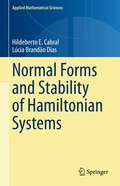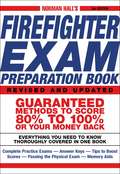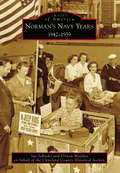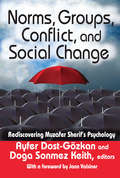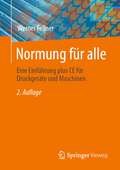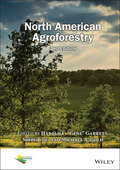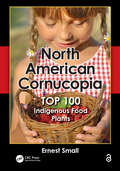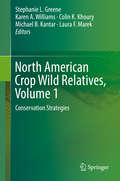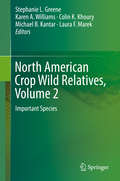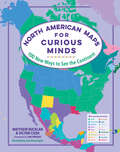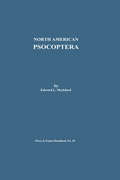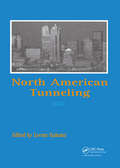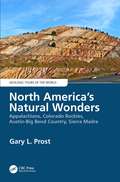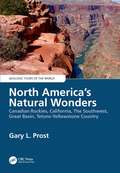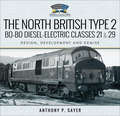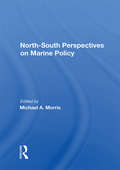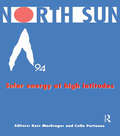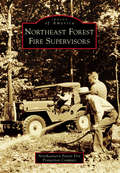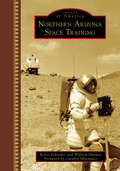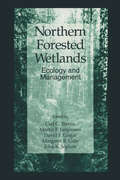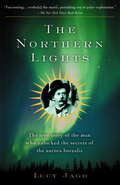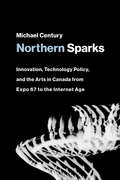- Table View
- List View
Normal Forms and Stability of Hamiltonian Systems (Applied Mathematical Sciences #218)
by Hildeberto E. Cabral Lúcia Brandão DiasThis book introduces the reader to the study of Hamiltonian systems, focusing on the stability of autonomous and periodic systems and expanding to topics that are usually not covered by the canonical literature in the field. It emerged from lectures and seminars given at the Federal University of Pernambuco, Brazil, known as one of the leading research centers in the theory of Hamiltonian dynamics. This book starts with a brief review of some results of linear algebra and advanced calculus, followed by the basic theory of Hamiltonian systems. The study of normal forms of Hamiltonian systems is covered by Ch.3, while Chapters 4 and 5 treat the normalization of Hamiltonian matrices. Stability in non-linear and linear systems are topics in Chapters 6 and 7. This work finishes with a study of parametric resonance in Ch. 8. All the background needed is presented, from the Hamiltonian formulation of the laws of motion to the application of the Krein-Gelfand-Lidskii theory of strongly stable systems. With a clear, self-contained exposition, this work is a valuable help to advanced undergraduate and graduate students, and to mathematicians and physicists doing research on this topic.
Norman Hall's Firefighter Exam Preparation Book
by Norman HallWant to be a firefighter? Do you know what is involved in taking the exam? Don't take a chance at failing a test that you could ace--learn from the expert, Norman Hall. For more than a decade, Norman Hall's Firefighter Exam Preparation Book has been the #1 test preparation book for prospective firefighters. Back by popular demand, Norman Hall has completely updated and revised this hugely successful book for this second edition, presenting new tips and time-tested methods for attaining the highest scores. Practice your skills using these features: tips on how to pass the physical requirements; practice exams with answer keys; memory aids to help candidates master the recall test; tables for self-scoring; insights on what a career in firefighting entails; a discussion of the final interview; and more! You will score 80% to 100% using Norman Hall's proven system. If you don't, your purchase price for this book will be fully refunded.
Norman Hall's Firefighter Exam Preparation Book
by Norman HallGuaranteed Top Scores on Your Firefighter's Exam!Want to be a firefighter? Do you know what is involved in taking the exam? Don't take a chance at failing a test you could ace--learn from the expert, Norman Hall.For more than a decade, Norman Hall's Firefighter Exam Preparation Book has been the #1 test preparation book for prospective firefighters. Back by popular demand, Norman Hall has completely updated and revised this hugely successful book for this second edition, presenting new tips and time-tested methods for attaining the highest scores.Practice your skills using features such as tips on how to pass the physical requirements, practice exams with answer keys, memory aids to help you master the recall test, tables for self-scoring, insights on what a career in firefighting entails, and a discussion of the final interview.You will score 80% to 100% using Norman Hall's proven system. If you don't, your purchase price for this book will be fully refunded. See inside for details! Use Norman Hall's Firefighter Exam Preparation Book, 2nd Edition to study hard and score at the top!
Norman Hall's Firefighter Exam Preparation Book
by Norman S. HallWant to be a firefighter? Do you know what is involved in taking the exam? Don't take a chance at failing a test that you could ace-learn from the expert, Norman Hall. For more than a decade, Norman Hall's Firefighter Exam Preparation Book has been the #1 test preparation book for prospective firefighters. Back by popular demand, Norman Hall has completely updated and revised this hugely successful book for this second edition, presenting new tips and time-tested methods for attaining the highest scores. Practice your skills using these features: Tips on how to pass the physical requirements Practice exams with answer keys Memory aids to help candidates master the recall test Tables for self-scoring Insights on what a career in firefighting entails A discussion of the final interview You will score 80% to 100% using Norman Hall's proven system. If you don't, your purchase price for this book will be fully refunded.
Norman's Navy Years: 1942-1959 (Images of America)
by Cleveland County Historical Society Sue Schrems Vernon MadduxIn 1944, A.L. Simon, a sailor at the Norman Naval Air Station, illustrated a booklet, "On the Beach," about Navy life in Norman, Oklahoma. The title he chose reflected the irony of the US Navy establishing two bases in a landlocked prairie town in 1942. The initial activation of the Navy bases (from 1942 to 1945) and their reactivation (from 1952 to 1959) greatly increased the employment rate and economy in Norman, offering locals a much-needed boost after the Great Depression of the 1930s. The men who influenced the Navy to choose Norman as the location for Navy installations were T. Jack Foster, of the Norman Chamber of Commerce; Joseph Brandt, president of the University of Oklahoma; and Savoie Lottinville, director of the University of Oklahoma Press.
Norms, Groups, Conflict, and Social Change: Rediscovering Muzafer Sherif's Psychology
by Ayfer Dost-GozkanThis book is about the life and work of a Turkish-American social scientist, Muzafer Sherif (1905�1988). He was known for his seminal work on norm and group formations, social judgment, and intergroup conflicts and cooperation. Although Sherif is identified as one of the founders of social psychology, his contribution to the science of psychology goes beyond the limits of social psychology as it is generally defined today.This volume aims to rediscover the theory and research of its subject in the socio-historical context of his time, as well as his relevance for contemporary psychology. Chapters cover a range of topics: an in-depth portrayal of Sherif's life and intellectual struggle in Turkey and in the United States; his metatheoretical considerations on the science of psychology; his theory and research on group and intergroup relationships, social norms and social change; formation and change of frames of reference, ego-involvements and identity; and psychology of slogans.Sherif had profound life experiences in different cultural contexts from the Ottoman Empire and World War I to American universities, which enabled him to see the essentiality of the historico-cultural context in the formation of human phenomena. Sherif's psychology is an elegant exemplar of an integrative science of psychology that is worth rediscovering.
Normung für alle: Eine Einführung plus CE für Druckgeräte und Maschinen
by Werner FellnerZu berücksichtigende Vorgaben aus Normen und Gesetzen bilden ein komplexes System mit vielschichtigen Wechselwirkungen. Mit Fokus auf Druckgeräte (Behälter und Rohrleitungen) und Maschinen, die in Europa in Verkehr gebracht werden sollen (CE-Kennzeichen!), bietet dieses Fachbuch eine Einführung in die Welt der Normen und Gesetze. Neben Philosophie und Struktur der Verbindlichkeiten vermittelt es notwendiges Fachwissen für die Konstruktion und Planung von Produkten. Es verdeutlicht die Verantwortung von Konstrukteuren und Planern und solchen, die es werden wollen. Das Buch hilft Ihnen bei der Analyse der Vorgaben und der Beschaffung der Informationen.
Normung für alle: Eine Einführung plus CE für Druckgeräte und Maschinen
by Werner FellnerBei der Konstruktion und Planung von Produkten und Anlagen ist eine Vielzahl von Vorgaben aus Normen und Gesetzen zu berücksichtigen. Diese bilden ein komplexes System mit vielschichtigen Wechselwirkungen. Dieses kompakte Fachbuch führt in die Welt der Normung ein und betrachtet dazu im Speziellen das Inverkehrbringen von Druckgeräten (Behälter und Rohrleitungen) und Maschinen. In Europa ist dies mit der CE-Kennzeichnung verbunden, die auf allen Produkten zu finden ist. Das Buch vermittelt die Philosophie und Struktur der Verbindlichkeiten und verdeutlicht die Verantwortung von Fachleuten in Konstruktion und Planung. Neben notwendigem Fachwissen zur Normung wird auch eine Hilfestellung für die Analyse der Vorgaben und der Beschaffung der Informationen gegeben.
North American Agroforestry (ASA, CSSA, and SSSA Books)
by Harold E. “Gene” Garrett Shibu Jose Michael A. GoldNorth American Agroforestry Explore the many benefits of alternative land-use systems with this incisive resource Humanity has become a victim of its own success. While we’ve managed to meet the needs—to one extent or another—of a large portion of the human population, we’ve often done so by ignoring the health of the natural environment we rely on to sustain our planet. And by deteriorating the quality of our air, water, and land, we’ve put into motion consequences we’ll be dealing with for generations. In the newly revised Third Edition of North American Agroforestry, an expert team of researchers delivers an authoritative and insightful exploration of an alternative land-use system that exploits the positive interactions between trees and crops when they are grown together and bridges the gap between production agriculture and natural resource management. This latest edition includes new material on urban food forests, as well as the air and soil quality benefits of agroforestry, agroforestry’s relevance in the Mexican context, and agroforestry training and education. The book also offers: A thorough introduction to the development of agroforestry as an integrated land use management strategy Comprehensive explorations of agroforestry nomenclature, concepts, and practices, as well as an agroecological foundation for temperate agroforestry Practical discussions of tree-crop interactions in temperate agroforestry, including in systems such as windbreak practices, silvopasture practices, and alley cropping practices In-depth examinations of vegetative environmental buffers for air and water quality benefits, agroforestry for wildlife habitat, agroforestry at the landscape level, and the impact of agroforestry on soil health Perfect for environmental scientists, natural resource professionals and ecologists, North American Agroforestry will also earn a place in the libraries of students and scholars of agricultural sciences interested in the potential benefits of agroforestry.
North American Cornucopia: Top 100 Indigenous Food Plants
by Ernest SmallMany North American plants have characteristics that are especially promising as candidates for expanding our food supply and generating new economically competitive crops. This book is an informative analysis of the top 100 indigenous food plants of North America, focusing on those species that have achieved commercial success or have substantial market potential. The book's user-friendly format provides concise information on each plant. It examines the geography and ecology, history, economic and social importance, food and industrial uses, and the economic future of each crop.
North American Crop Wild Relatives, Volume 1: Conservation Strategies
by Stephanie L. Greene Karen A. Williams Colin K. Khoury Michael B. Kantar Laura F. MarekThe plant species that humans rely upon have an extended family of wild counterparts that are an important source of genetic diversity used to breed productive crops. These wild and weedy cousins are valuable as a resource for adapting our food, forage, industrial and other crops to climate change. Many wild plant species are also directly used, especially for revegetation, and as medicinal and ornamental plants. North America is rich in these wild plant genetic resources. This book is a valuable reference that describes the important crop wild relatives and wild utilized species found in Canada, the United States and Mexico. The book highlights efforts taken by these countries to conserve and use wild resources and provides essential information on best practices for collecting and conserving them. Numerous maps using up-to-date information and methods illustrate the distribution of important species, and supplement detailed description on the potential value these resources have to agriculture, as well as their conservation statuses and needs. There is broad recognition of the urgent need to conserve plant diversity; however, a small fraction of wild species is distinguished by their potential to support agricultural production. Many of these species are common, even weedy, and are easily overshadowed by rare or endangered plants. Nevertheless, because of their genetic proximity to agriculturally important crops or direct use, they deserve to be recognized, celebrated, conserved, and made available to support food and agricultural security. This comprehensive two-volume reference will be valuable for students and scientists interested in economic botany, and for practitioners at all levels tasked with conserving plant biodiversity.The chapters 'Public Education and Outreach Opportunities for Crop Wild Relatives in North America' and 'Genetic Resources of Crop Wild Relatives – A Canadian Perspective' are open access under a CC BY 4.0 license via link.springer.com.
North American Crop Wild Relatives, Volume 2: Important Species
by Stephanie L. Greene Karen A. Williams Colin K. Khoury Michael B. Kantar Laura F. MarekThe plant species that humans rely upon have an extended family of wild counterparts that are an important source of genetic diversity used to breed productive crops. These wild and weedy cousins are valuable as a resource for adapting our food, forage, industrial and other crops to climate change. Many wild plant species are also directly used, especially for revegetation, and as medicinal and ornamental plants. North America is rich in these wild plant genetic resources. This book is a valuable reference that describes the important crop wild relatives and wild utilized species found in Canada, the United States and Mexico. The book highlights efforts taken by these countries to conserve and use wild resources and provides essential information on best practices for collecting and conserving them. Numerous maps using up-to-date information and methods illustrate the distribution of important species, and supplement detailed description on the potential value these resources have to agriculture, as well as their conservation statuses and needs. There is broad recognition of the urgent need to conserve plant diversity; however, a small fraction of wild species is distinguished by their potential to support agricultural production. Many of these species are common, even weedy, and are easily overshadowed by rare or endangered plants. Nevertheless, because of their genetic proximity to agriculturally important crops or direct use, they deserve to be recognized, celebrated, conserved, and made available to support food and agricultural security. This comprehensive two-volume reference will be valuable for students and scientists interested in economic botany, and for practitioners at all levels tasked with conserving plant biodiversity.
North American Maps for Curious Minds: 100 New Ways To See The Continent (Maps for Curious Minds #0)
by Matthew Bucklan Victor CizekThe Maps for Curious Minds series is back—with 100 vivid infographic maps that transform the way we understand the cultural and geographical wonders of North America No matter how well you think you know North America, the 100 infographic maps in this singular atlas uncover a trove of fresh wonders that make the continent seem like the center of the universe. Did you know that North America is where the first T. rex was found? Or that it’s where you can visit the world’s biggest geode as well as its oldest, tallest, and largest trees—not to mention the world’s tallest and steepest roller coasters?! Brimming with fascinating insight (Who is the highest-paid public employee in each state?) and whimsical discovery (Where can you visit the world’s largest island in a lake on an island in a lake on an island?), this book highlights the unexpected contours of geography, history, nature, politics, and culture, revealing new ways to see North America—and the hundreds of millions who call it home.
North American Psocoptera
by Edward L. MockfordNorth American Psocoptera provides a complete review of the 28 families, 78 genera and 287 species of the order Psocoptera found in the United States and Canada.This comprehensive book contains keys to all of the known taxa of Psocoptera which have been found in the study area, including three genera named as new. Not only are the native and established species included, but also those which have been taken at ports of entry in human commerce. The book contains differential diagnoses of the taxa above species level. For each named species there is an account consisting of synonymy, recognition features, relationships, distribution, and habitat. Included are 119 pages of illustrations, glossary, bibliography and index.
North American Tunneling 2002: Proceedings of the NAT Conference, Seattle, 18-22 May 2002
by Levent ÖzdemirThis volume includes the papers presented at the North American Tunneling 2002 Conference. The papers deal with three major aspects of underground construction: managing construction projects; public policy and underground facilities; and advances in technology.
North America's Natural Wonders: Appalachians, Colorado Rockies, Austin-Big Bend Country, Sierra Madre (Geologic Tours of the World)
by Gary ProstWritten by a career geologist with decades of experience in the field, North America’s Natural Wonders guides readers through the most iconic, geologically significant scenery in North America, points out features of interest, explains what they are seeing, and describes how these features came to be. Presented as classic excursions to some of the best-known natural wonders on the continent, Volume II focuses primarily on Central and Eastern North America, including the Appalachians, the Colorado Rockies, Austin-Big Bend Country, and the Sierra Madre. The trips detailed in this volume include stops at quintessential features, such as the Shenandoah Valley, Carlsbad Caverns, Big Bend National Park, and La Popa Basin of Nuevo León and Coahuila, Mexico, as well as many others. It also features discussions of lesser-known but equally interesting geologic formations and important information on accessing these sites. Features Clearly explains the geology of these regions with an emphasis on landscape formation Addresses issues of interest, such as fossils, earthquakes, mineral sites, mining, and oil fields Lavishly illustrated with numerous colorful maps and breathtaking geological landscapes and their various features These six self-guided tours explain to the curious layman, student, and geologist what they are seeing when they look at a roadcut or a quarry and enhances the experience far beyond simple sightseeing.
North America's Natural Wonders: Canadian Rockies, California, The Southwest, Great Basin, Tetons-Yellowstone Country (Geologic Tours of the World)
by Gary ProstWritten by a career geologist with decades of experience in the field, North America’s Natural Wonders provides everything the reader needs to understand the landscape. It guides readers through the most iconic, geologically significant scenery in North America, points out features of interest, explains what they are seeing, and describes how these features came to be. Presented as classic excursions to some of the best-known natural wonders on the continent, Volume I focuses primarily on Western North America, including the Canadian Rockies, California, the Southwest, Great Basin, and Tetons-Yellowstone Country. The trips detailed in this volume include stops at quintessential features, such as the glaciers and mountains of Banff National Park, Yosemite, the vineyards of Napa Valley, the California goldfields, the Grand Canyon, numerous parks in Utah, the geysers and hot springs of Yellowstone National Park, as well as many others. It also features discussions of lesser-known but equally interesting geologic formations and important information on accessing these sites. Features Addresses issues of interest, such as fossils, earthquakes, mineral sites, mining, and oil fields Lavishly illustrated with numerous colorful maps and breathtaking geological landscapes and their various features These five self-guided tours explain to the curious layman, student, and geologist what they are seeing when they look at a roadcut or a quarry and enhances the experience far beyond simple sightseeing.
The North British Type 2 Bo-Bo Diesel-Electric Classes 21 & 29: Design, Development and Demise (Locomotive Portfolios)
by Anthony P. SayerThis comprehensive history of these unique locomotives covers everything from performance issues to sightings, detail differences and liveries. The Type 2 Bo-Bo Diesel-Electric Classes 21 & 29 locomotives were constructed by the North British Locomotive Company in the early 1960s. Used in the Scottish region of British Railway, they ran into numerous problems and were withdrawn from service within a decade. Due in part to their short careers, these locomotives remain something of a mystery to train enthusiasts. The scant information available on them is very often riddled with misinformation. This authoritative volume corrects the record, presenting the most comprehensive and accurate account of the NBL Classes 21 & 29. Fully illustrated with photographs and detailed line drawings, this volume offers individual locomotive histories, complete technical specifications, accident and fire damage reports, storage histories, and a complete account of their disposal at both private companies and Glasgow Works.
North-south Perspectives On Marine Policy
by Michael A. MorrisThis book aspires to contribute to greater understanding of three major perspectives on marine policy: developed states' perspectives, developing states' perspectives, and interaction between first and second perspectives or North-South perspectives.
North Sun '94: Solar Energy at High Latitudes
by Kerr McGregorContains 69 papers presented at the North Sun conference held in Glasgow from 7-9 September 1994. The contributions include sections on: solar water heating; active solar heating; photovoltaic applications; solar modelling and design tools; solar buildings; and policy and implementation.
Northeast Forest Fire Supervisors (Images of America)
by Northeastern Forest CompactControlling wildfires has been a significant mission for the state and federal governments since the early 1900s. During this time, the agencies responsible for wildland fire management have worked jointly in many ways to minimize losses from fires and to constantly improve firefighting and fire management techniques. In 1967, a new organization was established among the 20 states within the northeastern area of the United States to unite the forest fire control supervisors from each of those states. Since then, the Northeast Forest Fire Supervisors have been charged with the responsibility to stimulate and promote the development and use of specialized forest fire equipment, including better techniques in fire prevention, presuppression, suppression, and improved training and safety methods.
Northern Arizona Space Training (Images of America)
by William Sheehan Kevin Schindler Foreword By ShoemakerDuring the 1960s and early 1970s, northern Arizona played a critical role in fulfilling President Kennedy’s bold challenge of sending humans to the moon. From the rocky depths of the Grand Canyon to lofty cosmic views from Flagstaff’s dark skies, northern Arizona was ideal for activities ranging from moon buggy testing and geology training to lunar mapping and mission simulation. Every astronaut who walked on the moon, from Neil Armstrong to Gene Cernan, prepared for his journey in northern Arizona, and all used maps created by Flagstaff artists to navigate their way around the lunar surface. This book captures the spirit of these pioneers with stunning images from NASA, the US Geological Survey, and others.
Northern Forested Wetlands Ecology and Management
by Carl C. TrettinForested wetlands are a major component of northern landscapes, important both for their ecological functions and their socioeconomic values. Historically, these lands have been used for timber and fiber products, hunting, fishing, trapping, food gathering, and recreation. There are many questions about the use and management of these lands in the future, particularly with respect to forest products, hydrology and water quality, plant and wildlife ecology, landscape dynamics, and wetland restoration. Northern Forested Wetlands: Ecology and Management provides a synthesis of current research and literature. It examines the status, distribution, and use of these wetland resources. The book focuses on understanding the role of wetlands in the landscape and on how to manage these wetlands and sustain their important functions. This is a primary reference text for the study and management of northern forested wetlands, providing a forum for information discovered by researchers and managers from many nations.
The Northern Lights: The True Story Of The Man Who Unlocked the Secrets of the Aurora Borealis
by Lucy JagoScience, biography, and arctic exploration coverage in this extraordinary true story of the life and work of Norwegian scientist Kristian Birkeland, the troubled genius who solved the mysteries of one of nature's most spectacular displays. Captivated by the otherworldly lights of the aurora borealis, Birkeland embarked on a lifelong quest to discover their cause. His pursuit took him to some of the most forbidding landscapes on earth, from the remote snowcapped mountains of Norway to the war-torn deserts of Africa. In the face of rebuke by the scientific establishment, sabotage by a jealous rival, and his own battles with depression and paranoia, Birkeland remained steadfast. Although ultimately vindicated, his theories were unheralded-and his hopes for the Nobel Prize scuttled-at the time of his suspicious death in 1917. The Northern Lightsoffers a brilliant account of the physics behind the aurora borealis and a rare look inside the mind of one of history's most visionary scientists.
Northern Sparks: Innovation, Technology Policy, and the Arts in Canada from Expo 67 to the Intern et Age (Leonardo)
by Michael CenturyAn &“episode of light&” in Canada sparked by Expo 67 when new art forms, innovative technologies, and novel institutional and policy frameworks emerged together.Understanding how experimental art catalyzes technological innovation is often prized yet typically reduced to the magic formula of &“creativity.&” In Northern Sparks, Michael Century emphasizes the role of policy and institutions by showing how novel art forms and media technologies in Canada emerged during a period of political and social reinvention, starting in the 1960s with the energies unleashed by Expo 67. Debunking conventional wisdom, Century reclaims innovation from both its present-day devotees and detractors by revealing how experimental artists critically challenge as well as discover and extend the capacities of new technologies.Century offers a series of detailed cross-media case studies that illustrate the cross-fertilization of art, technology, and policy. These cases span animation, music, sound art and acoustic ecology, cybernetic cinema, interactive installation art, virtual reality, telecommunications art, software applications, and the emergent metadiscipline of human-computer interaction. They include Norman McLaren&’s &“proto-computational&” film animations; projects in which the computer itself became an agent, as in computer-aided musical composition and choreography; an ill-fated government foray into interactive networking, the videotext system Telidon; and the beginnings of virtual reality at the Banff Centre. Century shows how Canadian artists approached new media technologies as malleable creative materials, while Canada undertook a political reinvention alongside its centennial celebrations. Northern Sparks offers a uniquely nuanced account of innovation in art and technology illuminated by critical policy analysis.
